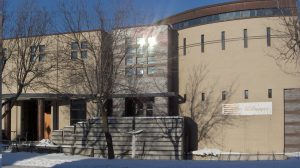In a Montreal café, the washroom is papered up to the ceiling with pages torn from an English-French dictionary. The tower of pages forces visitors to recognize the dictionary’s two divergent audiences: French-speaking people who rely on it to improve their English, and English speakers who use it to bone up on their French.
Like the dictionary, Hutchison Street, a novel by Abla Farhoud that was recently translated from the French, helps bridge cultural divides. Farhoud was born in Lebanon and came to Montreal with her family in 1951. She spent the early 1970s in Paris, but returned to Montreal for good in 1973, where she has written plays and novels in French.
READ: NOVEL IS AN INTRIGUING MIX OF MYSTERY AND HISTORY
Farhoud’s approach to Hutchison Street is lyrical and searching, a celebration of the street’s history, variety and potential.
Hutchison Street draws a map, a rectangle of streets representing the small section of Montreal where its action takes place, with Rue Bernard as its northern border, Mount Royal Avenue is to the south, Parc to the west and Hutchison in the east.
The rest of the city falls away as if it didn’t exist, the point being that Hutchison Street is itself a kind of self-contained village in the centre of a big city. Its occupants watch each other from balconies; they stop to chat on street corners; and houses stand side-by-side, while buildings divided into flats create even closer living quarters. People walk to do their shopping, to go to synagogue and to unwind after a busy day.
Hutchison, Farhoud tells us, draws a dividing line between the neighbourhoods of Outremont and Mile End. The street has always “had one sidewalk in Mile End and the other in Outremont. Feet spread apart, caught between two stools like the many immigrants who live in the neighbourhood. The street is none the worse for it.”
Mile End represents the city’s immigrant corridor. In recent decades, it has become Montreal’s zone of all-purpose inclusion, with cheap student rentals, restaurants, cafés, bookshops, a large music and artist community, alongside long-time residents.
Outremont attracted Jews from the Saint Laurent Boulevard area after the Second World War, but now boasts a substantial Hasidic community. What we see of this area in the news – and this is not what interests Farhoud – is the on-again-off-again conflict between French-speaking residents and their Hasidic neighbours over zoning issues and cultural differences.
Farhoud is interested in the street’s cultural divide, but as far as her characters see things, Hutchison is not a problem street. It is an urban paradise, a theatre of potential discovery.
Hutchison Street is built of short chapters, each one a detailed character study. We meet some figures repeatedly, as they become central to the story’s development. Others appear once or twice to convey the presence of Mile End’s artists, its small business owners, its widowers and widows who tend to their precious piece of the neighbourhood.
Three compelling central characters are female: two locals who are intensely curious about their Hasidic neighbours and 12-year-old Hinde Rochel, who keeps a diary as an account of her youthful ideals and wishes. Writing in her diary, Rochel considers how her community is seen from the outside:
“People know who we are and they don’t bother us. They avoid looking at us, they walk past as if we don’t exist. Except sometimes. I have seen mean people staring at us, but not very often. Sometimes, they look like they feel sorry for us. I see people talking to one another as they come toward us, they’re looking at us from a distance and I know they are talking about us. From the look on their faces, I can see that they are wondering how we can live like this.”
From across the street, Françoise, an established novelist, watches Rochel so attentively that a dream of the girl inspires her to write a novel about their street, to depict its mélange of Jewish, French and other city dwellers.
Françoise and Rochel share a love of Gabrielle Roy’s youthful writing. Each thinks deeply about the possibility of rapprochement between the street’s different populations. They are, in a sense, each community’s best possible ambassador. Once they’ve met, Rochel considers that “it was perhaps a very special occasion” for Françoise “to speak to a Hasidic girl. It was for me, too.”
Françoise realizes that “it was the first time in 39 years that she was reaching out to them, that she was testing the waters, so to speak.”
The third adventurer in this saga is Willa, a young mother who sneaks into the women’s balcony of a nearby synagogue. Once there, she feels “as if she were in a dream. Where on earth did she get this desire to make friends with these people?”
Still, she is insistent that her street presents possibilities for new overtures. “Hutchison does not separate Outremont from Mile End” in her mind, but “brings them together.”
Farhoud’s triumph in Hutchison Street is her willingness to avoid the common, even stereotypic, approaches to the street’s cultural divide. For her, it is a kind of theatre of everyday life, a true democratic place of meeting, of discourse and of belonging. Her pursuit of this aspect of contemporary Montreal is provocative and timely.






